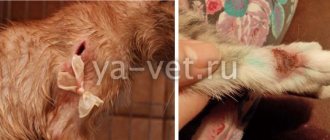When a cat with a fighting spirit lives in the house and periodically walks outside, the problem of injuring the animal arises very often. At such moments, owners unknowingly take first aid supplies from their own first aid kit and try to treat the cat’s wound, which is fundamentally wrong.
Let's find out which drugs (veterinary and medical) are allowed to be used for the treatment and treatment of cat wounds.
Treatment of superficial wounds in cats
Most often in everyday life, cats, for one reason or another, receive shallow skin wounds, which their owners can easily handle on their own at home. First of all, an animal that has been injured should be calmed down by being picked up and made to feel completely safe. Only after this is it possible to further treat the cat’s wound.
So, how can you treat a cat’s wound? This question worries many pet owners, especially if they are faced with a similar problem for the first time. Treatment of superficial skin lesions in cats should begin with high-quality washing of the wound surface with disinfectants or bactericidal agents. This is necessary to prevent the development of an inflammatory process in the wound with subsequent suppuration. For reliable disinfection, it is better to use a hydrogen peroxide solution or a chlorhexidine solution, which are usually found in any home medicine cabinet.
When deciding how to treat a cat’s wound at home, you should remember Levomekol ointment. This product for external use not only has an excellent bactericidal effect, but also has an analgesic effect, and also helps to accelerate the regenerative processes of the skin and its rapid healing. It is important to remember that before treating wounds on pets, it is necessary to remove all hair from the skin surfaces in the area of damage, and after applying disinfectants, carefully apply a gauze bandage or bandage the wound if it is on the paw.
What are the causes of abscesses?
There are many potential causes of abscesses in cats. One of the most common causes is a bite from another animal. A bite is a penetrating wound to the skin by teeth that are infected and the wound also becomes infected. The same principle applies to the formation of abscesses when cats scratch each other. An abscess can also occur when the skin and mucous membranes are damaged by spikelets of grass, tree branches and other sharp objects. At the same time, the wound itself is not as noticeable at the moment the animal receives it, as the abscess is noticeable after its formation. Abscesses do not always appear with bites and injuries; it depends on the depth of the wound and what bacteria got into the wound.
The following are the types of bacteria that often lead to abscesses:
- pus-forming bacteria such as Staphylococcus, Escherichia coli, some types of Streptococci, Pseudomonas aeruginosa, Mycoplasma, Pasteurella multocida, Corynebacteria, Actinomycetes, Bartonella;
- anaerobic bacteria that can only develop in the absence of oxygen, for example, Bacteroides, Clostridia, and Fusobacteria.
How to treat deep wounds in a cat?
Deep and open wounds in cats should be treated by a veterinarian. As a rule, such a laceration in a cat occurs as a result of a fight with dogs, and therefore often requires surgical suturing in a veterinary office or clinic. Naturally, before visiting a specialist, the damaged surface should be treated with an antiseptic to avoid infection of the soft tissues. After surgical suturing of the edges of the wound, the specialist must prescribe outpatient treatment to the animal using external agents that promote the healing of damaged skin and prevent infectious agents from penetrating into its deeper layers.
How are abscesses treated?
Treatment for an abscess depends on its location and the severity of the infection. Most abscesses are treated on an outpatient basis. First, the abscess is opened and drained surgically, and in addition to removing pus from the abscess cavity, necrotic tissue and sometimes the foreign object that caused the abscess are removed. If a foreign object causes an abscess, it is important to make sure that it is completely removed from the cavity, otherwise the abscess may recur.
It is important to provide adequate pain relief during abscess treatment.
Antibiotic therapy is one of the most important components of successful treatment of an abscess, regardless of its location. Antibiotics are selected based on the results of bacterial culture, i.e. those to which the bacteria are sensitive or, in the absence of such a study, broad-spectrum antibiotics are used. It is important to use the antibiotic for the entire period prescribed by the attending physician. It is also important to provide adequate pain relief during abscess treatment.
During treatment in cats, it is necessary to ensure that the animal is adequately fed. This is very important for a quick recovery. Your veterinarian may prescribe a special diet during treatment.
It is also important to confine the active animal to the space to allow the wound to heal as quickly as possible. This is especially important if the abscess was opened surgically and drainage was installed in the wound or a bandage was placed on the animal.
Treatment of purulent wounds
Treatment of purulent wounds in cats is a complex and labor-intensive process that pursues several goals at once: eliminating the source of inflammation, preventing the spread of infection to neighboring tissues or its entry into the blood, as well as high-quality care for your pet, which will allow it to quickly cope with the disease. It is better to entrust the entire process of treating an infected wound in an animal to an experienced veterinarian, who, before treating a purulent wound in a cat, will assess the extent of the spread of inflammation and make the only right decision regarding further tactics and the choice of treatment method.
As a rule, when wounds in cats suppurate, a specialist prescribes general injectable antibiotics to the animal. Additionally, the wound surface should be treated with an antiseptic solution several times a day, followed by applying ointments to the wound surface that draw out pus and promote healing of damaged skin surfaces. In some cases, when the infection cannot be stopped by conservative methods, the animal owner is offered surgical excision of the infected tissue or amputation of the pet’s limb damaged by the pathological process.
Types of disease
Most often, abscesses occur on the skin of the animal, as well as mucous membranes. Depending on the location of the source of suppuration, abscesses are divided into several types:
- Superficial - located under the epidermis layer, are small in size and very rarely cause sepsis;
- Deep - develop in the muscle area and subcutaneous fatty tissue; as a rule, they can only be detected by touch;
- Odontogenic - occurs due to problems with teeth;
- Paraanal - arise due to the presence of an inflammatory process in the paraanal glands of the animal;
- Suppuration on the head, paws, neck, and back of the body.
Abscesses in the cheek or eye area are very rare.
Features of care and feeding patterns for cats with wounds
A cat that has been diagnosed with a wound should be kept at rest until all injuries are completely healed. It is not recommended to let such a pet outside, and it is also necessary to protect it as much as possible from contact with other animals. Feeding plays an important role in the rehabilitation process of a cat with a wound. It must be balanced and aimed at fighting infection:
- Foods with irritating effects should be removed from the cat’s diet: smoked meats, sausages, sweets;
- it is necessary to increase the amount of vegetables, which contain vitamins and microelements necessary to stimulate the immune system;
- Additionally, you can give a sick cat synthetic vitamin complexes prescribed by a veterinarian.
Symptoms
An attentive owner will notice an abscess in a cat on his own. A change in the pet's character and an alarming reaction to touch in certain places may indicate the presence of this problem. Most often, the abscess can be found on the tail, paws, neck and head. It is these parts of the body that cats scratch the enemy during a fight.
A mature abscess can be seen with the naked eye: swelling and redness appear. If the wound is open, blood and pus begin to come out of it, and an unpleasant odor appears. The cat experiences a rise in temperature, lethargy, and his appetite worsens or completely disappears.
If the animal has good immunity, then the abscess can burst, pus will flow out of it, and the wound will heal. But it often happens that the outflow does not form, and the abscess itself causes severe suffering to the animal. At the same time, it becomes very aggressive, completely refusing to eat and communicate with its owners.
The course of an abscess in cats:
- Infection in the wound;
- The appearance of redness and swelling;
- The occurrence of a local increase in temperature in the area where there was previously a wound;
- The area becomes painful;
- A large tumor appears, the skin becomes very red;
- Through a thin layer of skin you can see and feel a lesion with pus;
- Self-opening of an abscess or spreading of pus to surrounding tissues.
Pets that spend a lot of time outside the home, on the street, in places with large concentrations of animals are highly susceptible to this disease.
Rules for treating wounds at home
Knowing how to treat an open wound on a cat will help when it is not possible to see a veterinarian. No pet is immune to injury, so first aid is a vital skill.
Heavy bleeding
Bleeding is often observed in open wounds. Such damage can vary from small scratches to wounds with the presence of flesh.
If the leg or tail is injured, it is recommended to apply a tight bandage to stop the bleeding. This solution helps with arterial bleeding, when the color of the blood has a scarlet tint. If the blood is dark in color, then the bleeding is venous. In this case, it is necessary to treat the area with an antiseptic and apply a cotton-gauze bandage.
Wounds in the neck and abdomen are held with a large layer of absorbent wipes or taped to the surface. If you have a sterile collagen sponge in the house, you can use it. It is not recommended to open the wound until the bleeding stops.
After providing first aid, you must take the animal to a veterinarian. The doctor will explain further steps.
Important! If the bleeding could not be stopped at home, then in a hospital setting special anticoagulants are used - vikasol, dicinone.
Treatment of minor injuries
Treatment for minor cuts is as follows:
- Wash your hands with soap and treat them with an antiseptic.
- The hair around the wound should be shaved or trimmed short with sterile instruments.
- If dirt is present, clean the area with clean water.
- Treat the wound with a cotton swab dipped in an antiseptic.
- Apply a bandage.
To treat minor scratches, use brilliant green. This product has an antiseptic and drying effect.
Important! Do not pour brilliant green into deep wounds.
The procedure is repeated several times a day until complete healing. The wound should be carefully sealed so that the cat cannot lick or scratch it.
How to treat deep wounds in a cat
Serious injuries should be treated by a veterinarian. The owners can provide first aid, but only a doctor can examine the wound and determine the source of the lesion. In some cases, there are lacerations that require surgery and cannot be treated at home.
Even when surgery is not required, the cat must be taken to the doctor regularly to apply bandages and monitor the general condition of the animal. If the animal's health is not in danger, the veterinarian can instruct the owners to care for the pet's wound and bring it in for regular checkups.
With deep injuries there is a risk of infection
Treatment at home for a purulent wound
Purulent wounds indicate the presence of infection within the lesion. Wounds with pus can be either open or closed. In the first case, the pus comes out freely, which is safer for the animal. Closed lesions with pus turn into an abscess, which must be opened and cleaned.
When the affected area festers, the area around it becomes swollen and red. The pet's body temperature often rises, it has a fever, there is lethargy and a reluctance to eat.
If a cat has a purulent wound on its head, what to do and how to treat it depends on whether the injury is open or closed. If pus comes out of the wound, the area is washed with furatsilin 2-4 times a day. You can use Levomekol or Methyluracil ointments, as they are effective in treating cocci and Pseudomonas aeruginosa.
Important! If there is pus, you should contact your veterinarian. In the hospital, the cat will undergo a microbiological analysis, which will determine the affected area, as well as the presence of infection in the body.
A cat’s wound has festered; every owner should know how to treat it and what to do if an abscess develops, since this pathology is life-threatening for the pet.
The first step is to open the abscess. To avoid re-infection, the procedure should be performed at a veterinary clinic. After cutting the wound, a drainage is installed, which allows the pus to escape out. Subsequently, antiseptic solutions and ointments are used for washing.
Abscesses after fights often appear on the pet's face, since this is the place that suffers the most from the paws of another animal.
Burn
To reduce pain after a burn, first apply a cold compress. The faster the owners do this, the less the pet will have a blister in the future. To check the extent of the damage, you need to examine the skin and pull back a few hairs. If it becomes easier at the site of the injury, then the burn is serious and the pet should be taken to the veterinarian.
Important! Do not open blisters or blisters at the burn site. In this case, the cat’s pain will intensify and the healing process will become more complicated.
For small lesions, it is enough to anoint the area with Bepanten ointment. The treatment is done several times a day until the burn heals.
Treatment
The first thing they do when diagnosing an abscess is novocaine blockade, this will relieve the pain syndrome. Then the site of the abscess is warmed up with heat (compresses, heating pads, lotions). This will speed up the process of abscess maturation. Next, the neoplasm is opened (with a scalpel or needle), the entire contents of the wound are removed, disinfected with antiseptic drugs and an antimicrobial agent (ointment, cream, gel) is applied. The procedure for removing an abscess is not a pleasant one; to perform it, the pet will have to undergo general anesthesia.
A drainage is placed inside the suture to drain purulent discharge and ichor. It is usually removed 5 days after surgery. All this time, the little patient will be given antibiotics to prevent relapse and given painkillers. A special cone-shaped collar is placed on the pussy's neck so that she cannot reach freshly treated wounds with her tongue. As a rule, about a week after cleaning the wound is enough for the infiltrate to resolve completely.
Self-help for your pet
What to do if visiting the clinic is difficult for some reason? Here's a little guide to action:
- Warm the abscess until it ripens (the procedure is allowed only if the cat does not have a fever).
- Open the abscess (you can use a needle calcined over a fire or disinfected with alcohol).
- Use sterile alcohol wipes to blot away any pus.
- Disinfect the wound with hydrogen peroxide (furacelin solution is allowed).
- Apply a bandage with medicinal ointment (Vishnevsky, ichthyol, etc.).
- Dressing and washing the wound should be done daily until the pus is completely cleared.
But at the first opportunity, show the animal to a specialist. Infection is an unpredictable thing, complications can be the most unexpected.
Necessary diagnostic measures
The manifestation of parallel symptoms indicates the need to show the animal to a specialist.
When a cat scratches its neck until it bleeds and other unpleasant symptoms are observed, you should contact a veterinary clinic. The specialist will examine the pet’s damaged skin and assess the animal’s general condition. Simple disorders such as allergies can be determined by visual inspection and determination of the cat’s diet or its possible contact with irritants. If it was not possible to determine the causes of wounds on the neck in this way, then additional diagnostics are carried out, which include the following manipulations:
- laboratory blood test;
- general analysis and bacterial culture of urine;
- allergic reaction test;
- scraping to identify pathogenic microorganisms.
Possible complications
The danger of an abscess is that this disease can cause severe complications that significantly worsen the pet’s condition and can also be fatal.
Complications of an abscess:
- Overgrowth of affected areas, formation of purulent phlegmon;
- Tissue necrosis;
- Blood poisoning;
- Sepsis;
- Death.
Often, through the wound that led to the formation of an abscess, the pathogens of rabies, feline leukemia or immunodeficiency virus penetrate and spread throughout the body.
In order to avoid serious consequences for the animal’s body, it is necessary to contact a veterinarian as soon as possible after discovering an abscess in a cat.











